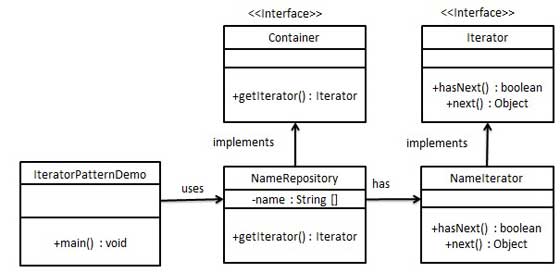Iterator pattern is very commonly used design pattern in Java and .Net programming environment. This pattern is used to get a way to access the elements of a collection object in sequential manner without any need to know its underlying representation.
Iterator pattern falls under behavioral pattern category.
Implementation
We're going to create a Iterator interface which narrates navigation method and a Container interface which retruns the iterator . Concrete classes implementing the Container interface will be responsible to implement Iteratorinterface and use it
IteratorPatternDemo, our demo class will use NamesRepository, a concrete class implementation to print a Names stored as a collection in NamesRepository.

Step 1
Create interfaces.
Iterator.java
public interface Iterator { public boolean hasNext(); public Object next(); }
Container.java
public interface Container { public Iterator getIterator(); }
Step 2
Create concrete class implementing the Container interface. This class has inner class NameIterator implementing the Iterator interface.
NameRepository.java
public class NameRepository implements Container { public String names[] = {"Robert" , "John" ,"Julie" , "Lora"}; @Override public Iterator getIterator() { return new NameIterator(); } private class NameIterator implements Iterator { int index; @Override public boolean hasNext() { if(index < names.length){ return true; } return false; } @Override public Object next() { if(this.hasNext()){ return names[index++]; } return null; } } }
Step 3
Use the NameRepository to get iterator and print names.
IteratorPatternDemo.java
public class IteratorPatternDemo { public static void main(String[] args) { NameRepository namesRepository = new NameRepository(); for(Iterator iter = namesRepository.getIterator(); iter.hasNext();){ String name = (String)iter.next(); System.out.println("Name : " + name); } } }
Step 4
Verify the output.
Name : Robert Name : John Name : Julie Name : Lora
No comments:
Post a Comment